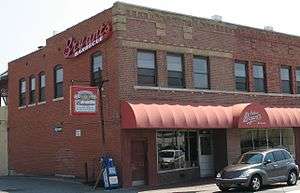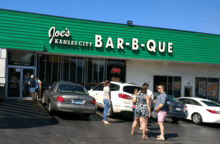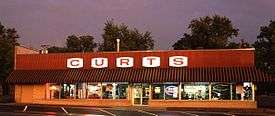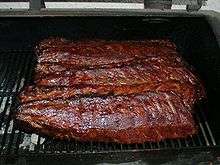Kansas City-style barbecue
Kansas City-style barbecue refers to the specific regional barbecue style of slowly smoked meat that originated from the pit of Henry Perry in the early 20th century in Kansas City, Missouri.
.jpg) Kansas City-style barbecue combo plate with various meats and fries | |
| Type | Lunch, dinner |
|---|---|
| Place of origin | United States |
| Region or state | North America |
| Associated national cuisine | United States |
| Main ingredients | Beef, chicken, and pork |
Characteristics
Kansas City barbecue is characterized by its use of a wide variety of meats: pork, beef, chicken, turkey, lamb, sausage, and sometimes even fish. Just about any type of barbecued meat served in the country's other barbecue capitals, from pulled pork to brisket to beef ribs and pork ribs in a number of different cuts, is served in KC-area barbecue restaurants. Burnt ends – the crusty, fatty, flavorful meat cut from the point of a smoked beef brisket – are much in demand.
Kansas City barbecue is rubbed with spices, slow-smoked over a variety of woods and served with a thick tomato-based barbecue sauce,[1] which is an integral part of KC-style barbecue.[2] Most local restaurants and sauce companies offer several varieties with sweet, spicy and tangy flavor profiles, but the staple sauce tends to be both sweet (often from molasses) and spicy. Kansas City barbecue is also known for its many side dishes, including a unique style of baked beans, French fries, coleslaw, and other Southern-food staples.
Barbecue in Kansas City
The Kansas City metropolitan area has more than 100 barbecue restaurants, a number of which are nationally renowned.[3] The area is also home to several large barbecue cooking contests, notably the Great Lenexa BBQ Battle[4] and the American Royal World Series of Barbecue, the largest barbecue competition in the world.[5][6]
History
Henry Perry
Urban Kansas City traces its barbecue history to Henry Perry, who operated out of a trolley barn at 19th and Highland in the legendary African-American neighborhood around 18th and Vine.
Perry served slow-cooked ribs on pages of newsprint for 25 cents a slab. Perry came from Shelby County, Tennessee, near Memphis, and began serving barbecue in 1908. Kansas City and Memphis barbecue styles are very similar, although Kansas City tends to use more sauce and a wider variety of meats. Perry's sauce had a somewhat harsh, peppery flavor.
Perry's restaurant became a major cultural point during the heyday of Kansas City Jazz during the "wide-open" days of Tom Pendergast in the 1920s and 1930s.
Arthur Bryant

Working for Henry Perry was Charlie Bryant, who, in turn, brought his brother, Arthur Bryant, into the business. Charlie took over the Perry restaurant in 1940 after Perry died. Arthur then took over his brother's business in 1946, and the restaurant was renamed Arthur Bryant's.
Arthur Bryant's, which eventually moved to 1727 Brooklyn in the same neighborhood, became a stomping ground for baseball fans and players in the 1950s and 1960s, because of its close proximity to Municipal Stadium, where the Athletics or A's played their home games during that period.
In April 1972, Kansas City native Calvin Trillin wrote an article in Playboy proclaiming Bryant's to be the best restaurant on the planet.
Despite new-found fame, Bryant did not change the restaurant's very simple decor, which consisted of fluorescent lighting, formica tables, and five-gallon jars of sauce displayed in the windows, even as Presidents Harry Truman, Jimmy Carter and Ronald Reagan stopped by.
Bryant died of a heart attack, in a bed that he kept at the restaurant, shortly after Christmas of 1982. The restaurant is still open. The sauce and restaurant continue their success.
Along the main inner wall of the restaurant is photographic history of many famous politicians, actors, actresses and sports figures and other tribute pictures of military personnel displaying Arthur Bryant's memorabilia such as shirts or bottles of sauce.
Gates & Sons
In 1946 Arthur Pinkard, who was a cook for Perry, joined with George Gates to form Gates and Sons Bar-B-Q. The restaurant was situated initially in the same neighborhood.

Gates barbecue sauce does not contain molasses; the ingredients, as listed on the bottle, are: "Tomatoes, vinegar, salt, sugar, celery, garlic, spices, and pepper. 1/10 of 1% potassium sorbate preservative added." It is available in Original Classic, Mild, Sweet & Mild, and Extra Hot varieties.
Gates also expanded its footprint in a more conventional way, with restaurants all displaying certain trademarks – red-roofed buildings, a recognizable logo (a strutting man clad in tuxedo and top hat) and the customary "Hi, May I Help You?" greeting belted out by its employees as patrons enter.
Gates has opened restaurants throughout the Kansas City metropolitan area. The chain currently consists of 6 area Gates Bar-B-Q restaurants: 4 in Missouri, 2 in Kansas. Gates also has sold barbecue sandwiches at Kauffman Stadium during Kansas City Royals home games, and currently at Arrowhead Stadium during Kansas City Chiefs home games.
Other notable restaurants
Fiorella's Jack Stack Barbecue
Fiorella's Jack Stack Barbecue had its beginnings as the second restaurant in the Smokestack BBQ chain, which Russ Fiorella, Sr. had started in 1957. Fiorella's eldest son Jack worked with his father until 1974, when he and his wife Delores opened their own Smokestack location in the Martin City neighborhood of south Kansas City.[7]
Eventually Jack, along with his wife and children, decided to expand their menu selections, adding non-traditional barbecue menu items like hickory-grilled steaks, lamb ribs, Crown Prime Beef Short Ribs, and fresh, hickory-grilled seafood, along with an extensive wine and bar selection. They also began offering a higher level of comfort and service than most people were accustomed to at a barbecue restaurant. Smokestack BBQ in Martin City soon became one of the most successful restaurants in the Kansas City metro. In 1996, Jack Fiorella was named Restaurateur of the Year by the Greater Kansas City Restaurant Association.[8]
By the mid-1990s, Jack Fiorella decided to replicate the success of his Martin City Smokestack restaurant. Other members of the Fiorella family told Jack that he was not permitted to use the Smokestack name for his new restaurant, so both the new restaurant (opened in 1997 in Overland Park, Kansas) and Jack's existing restaurant in Martin City dropped the Smokestack name and were rebranded as Fiorella's Jack Stack Barbecue. They also opened a full-service catering operation in Martin City and their third location in the historic Freight House building in the Crossroads Arts District. They began shipping their barbecue nationwide in 2000, and in October 2006 they opened a fourth location on The Country Club Plaza. In 2014, a fifth Jack Stack restaurant opened in Lee's Summit, Missouri. The original Smokestack chain closed its last remaining location in 2012.
Fiorella's Jack Stack Barbecue has been featured on The Food Network and The History Channel, and has been rated as among the best barbecue in the United States by several national organizations and magazines. Most notably, the Zagat Survey has named it the "#1 Barbecue House in the Country."[9]
Joe's Kansas City

Joe’s Kansas City Bar-B-Que can be traced to competition barbecue and the Kansas City Barbeque Society (KCBS). Accompanying friends at the American Royal and The Great Lenexa BBQ Battle inspired Jeff Stehney to start cooking on his own. The first smoker purchased was an Oklahoma Joe’s 24” smoker, christened in April 1991.
By 1993, Jeff, his wife and business partner Joy, and Jim "Thurston" Howell were ready to make their mark on the KCBS competition circuit. Their competition team, Slaughterhouse Five, ended up winning eight Grand Championships, including the prestigious American Royal BBQ, three Reserve Grand Championships, and the KCBS’s Grand Champion “Team of the Year” in 1993. Over the next several seasons Slaughterhouse Five won dozens more awards and was generally recognized as one of the top competition BBQ teams in the Country.
Jeff and Joy opened Oklahoma Joe's Bar-B-Que (later renamed to Joe’s Kansas City Bar-B-Que) in a gas station in Kansas City, Kansas in 1996.[10] There are also locations in Olathe, Kansas and Leawood, Kansas.
Celebrity chef Anthony Bourdain listed Joe's original Kansas City, Kansas location as one of "13 Places You Must Eat Before You Die".[11] Men's Health magazine named it America's manliest restaurant.[12] Joe's was featured on Season 3 of Man v. Food in August 2010.[13] It was also named "Kansas City's Best Barbecue" by Zagat.[14]
KC Masterpiece
In 1977, Rich Davis capitalized on the reputation of Kansas City barbecue to form KC Masterpiece, which evolved from his "K.C. Soul Style Barbecue Sauce". KC Masterpiece is sweeter and thicker than many of the traditional Kansas City sauces served in the region. The KC Masterpiece recipe uses extra molasses to achieve its thick, sweet character.
KC Masterpiece was sold to the Kingsford division of Clorox in 1986 and now claims to be the number one premium barbecue brand in the U.S. When Davis sold the rights to his sauce to Kingsford, he announced plans to build a franchise of barbecue restaurants. The franchises were successful for a few years, but have since all closed.
Curt's Famous Meats

Curt's Famous Meats is a meat market founded in 1947 by Curtis Jones and sold to Donna Pittman in 1989. With clientele from all across America, Curt's specializes in barbecue prepared with Kansas City rub. It has a long history of award-winning barbecue, having won eight times the American Royal barbecue competition, the largest in the world. Curt's is located on East Truman Road in the Maywood neighborhood of Independence, Missouri. Although not in Kansas City proper, Curt's has been a large competitor in many local competitions in barbecue.[15] Curt's Famous Meats is also known for its predominantly female staff that Donna Pittman has hired. They are known locally as the Lady Meat Cutters.[16]
Jones Bar-B-Q
Jones Bar-B-Q is an independent barbecue joint on Kaw Drive in Kansas City, Kansas, owned by Deborah and Mary Jones.
In 2001 Doug Worgul featured Jones Bar-B-Q in the afterword of The Grand Barbecue: A Celebration of the History, Places, Personalities and Techniques of Kansas City Barbecue.[17]:120 Worgul said the sisters' barbecue "represent[ed] an artisan approach that cannot be replicated in higher-volume barbecue restaurants" and calls the location, a former taco stand, "the jointiest joint I've ever seen."[18] In 2016 Ardie Davis called it "old school", saying the barbecue is straightforward, not oversmoked, and not overtrimmed.[18]
As of 2016 the Kansas City Star considered them possibly the only Kansas City barbecue owned and operated by women pitmasters.[19][20][21] The sisters do not participate in the barbecue competition circuit.[22]
In 2018 they appeared on an episode of Steve Harvey's Steve in a segment titled "The Queens of Barbecue."[23][24]
In March 2019 the sisters and the barbecue were featured on the third season of American television series Queer Eye,[25] which was filmed in and near Kansas City.[26] Both they and the restaurant received a makeover, and they started bottling their sauce.[25] In the aftermath they had to put in a second barbecue pit to handle demand.[22]
In 2019 Jones Bar-B-Q's Coconut Pineapple sauce was named by Bloomberg News as one of their five favorite barbecue sauces.[27]
Kansas City Barbeque Society
The Kansas City Barbeque Society (KCBS) was founded in 1986. With over 13,000 members worldwide, it is the world’s largest organization of barbecue and grilling enthusiasts. KCBS is a nonprofit organization dedicated to "promoting barbecue as America's cuisine and having fun while doing so."[28]
KCBS sanctions nearly 300 barbecue contests across the U.S. each year and offers assistance to civic and charitable organizations with producing these events. The KCBS has developed a set of rules and regulations that govern all official KCBS competitions.
KCBS offers educational programs, consultation services and civic organization presentations to help spread the gospel of barbecue. The mission of the Kansas City Barbeque Society is to celebrate, teach, preserve and promote barbecue as a culinary technique, sport and art form.
See also
References
- "Experience Kansas City - Barbeque Kansas City Style". Experiencekc.com. Retrieved 2015-05-14.
- Fazio, Heather (June 1, 2015). "Prominent BBQ Styles In The United States". Retrieved 2019-11-30.
- "Kansas City Barbecue Restaurant List". Official Kansas City Restaurant Listing. Retrieved 2013-10-04.
- "Great Lenexa BBQ Battle". www.lenexa.com. Retrieved 2020-08-03.
- "BBQ". American Royal. Retrieved 2020-08-03.
- Gorce, Tammy La (2012-06-29). "Fire Up the Pit: My Brisket Can Burn Yours". The New York Times. ISSN 0362-4331. Retrieved 2020-08-03.
- "Ribs and Ritual in Kansas City". SAVEUR. 2011-06-08. Retrieved 2015-05-14.
- "From the Embers".
- "Fiorella's Jack Stack Barbecue at the Freight House". The Kansas City Convention & Visitors Association. Archived from the original on 2008-04-06. Retrieved 2008-01-17.
- Olmsted, Larry (2013-09-10). "Share". USA Today.
- "International Dining | Men's Health". Menshealth.com. Retrieved 2015-05-14.
- Polis, Carey (2012-11-21). "The Manliest Restaurant In America". Huffington Post.
- Tone, Joe (2010-08-12). "Man v. Food takes on Oklahoma Joe's, Stroud's and one gross sando at Papa Bob's Bar-B-Que | The Fast Pitch". The Pitch. Retrieved 2015-05-14.
- 13 places to eat - Oklahoma Joe's
- "Heroes can be closer than you think". 2009. Archived from the original on 2011-09-27. Retrieved 2011-05-05.
- ""Behind the Grind" Story". KMBC Channel 9 News. 2006-07-21. Retrieved 2011-04-10.
- Worgul, Doug (2001). The Grand Barbecue: A Celebration of the History, Places, Personalities and Techniques of Kansas City Barbecue. Kansas City Star Books. ISBN 978-0-9709131-2-8.
- Wendholt Silva, Jill (August 30, 2016). "True pitmasters: The Jones sisters are rare gems in man's world". KansasCity.com. Retrieved August 24, 2019.
- Silva, Jill (August 30, 2016). "Why female barbecue pitmasters are still a rarity in KC and beyond". Kansas City Star. Retrieved August 24, 2019.
- "You Can Now Buy The BBQ Sauce From The Jones Sisters As Seen On Netflix's 'Queer Eye'". Essence. Retrieved 2019-08-24.
- Williams, Corey (March 19, 2019). "This BBQ Sauce Is Flying off Shelves After 'Queer Eye' Made It Famous". Food & Wine. Retrieved August 24, 2019.
- Lynn, Samara (March 28, 2019). "Life after "Queer Eye": Interview with Deborah Jones, Co-Owner of Jones BBQ". Black Enterprise. Retrieved August 24, 2019.
- Midkiff, Sarah (March 17, 2019). "The Jones Sisters Got The Queer Eye Glow Up This Weekend & Sold Out Of Their Famous BBQ Sauce". www.refinery29.com. Retrieved August 24, 2019.
- "Secrets of the 'Queens of BBQ' Kansas City Smoke Sisters". IMDb. Retrieved August 25, 2019.
- Morabito, Greg (March 18, 2019). "'Queer Eye' Sends Jones Bar-B-Q Sauce Sales Through the Roof". Eater. Retrieved August 24, 2019.
- Bradley, Laura (March 20, 2019). "Queer Eye Update: The Jones Sisters' Barbecue Business Is Booming". Vanity Fair. Retrieved August 24, 2019.
- Kronsberg, Matthew (June 18, 2019). "Five Barbecue Sauces That Will Test Your Regional Allegiances". www.bloomberg.com. Retrieved August 24, 2019.
- "Kansas City Barbeque Society". Kcbs.us. Retrieved 2015-05-14.
